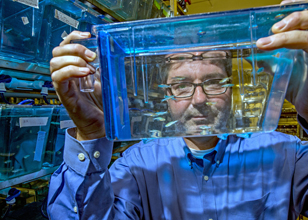
Zebra Fish Offer Clear View Of Life-saving Knowledge
Zebrafish are tiny vertebrates, but if you ask Jeffrey Essner, their significance to genetics research and cancer research is huge.
Essner is an associate professor in genetics, development and cell biology. He says the idea that he can improve human health—especially the idea that he can make a difference to cancer patients—motivates him in his research, which is funded by the National Institutes of Health.
Zebrafish—tiny, seemingly insignificant fish help him work toward that lofty goal. They also inspire him on another level: he enjoys looking at them.
“The embryos are just fascinatingly beautiful,” Essner says.
Their embryos are optically clear, so zebrafish development is easy to observe under a microscope. Also, since fish embryos develop outside of the mother, researchers can manipulate them, and that works well for genetic engineering and identifying genes involved in disease processes. Zebrafish also happen to be prolific breeders (a given female will produce up to 400 embryos in one morning).
“We can generate lots of embryos,” Essner says. “We can look at mutants and get statistical relevance from the numbers of offspring we’re examining.”
Precision is key
Essner has been using zebrafish to study a new method for genomic editing which uses artificial transcription activator-like effector nucleases (TALENs). This method allows researchers to cut DNA at specific sites and modify genetic information.
“We can go into any gene and introduce specific changes to the DNA with incredible precision,” Essner says. “This technology has implications for working with large animals and human gene therapy.”
Since zebrafish embryos develop outside of the mother, and since they are transparent, they are ideal for perfecting the use of TALENs in genomic editing. The embryos are easily accessed for microinjection, and the characteristics expressed by the modified genes are easily observed.
Essner, along with Ying Wang, a postdoctoral research associate in genetics, development and cell biology, and former ISU professor Dan Voytas, recently published an article in the journal Nature documenting the efficient use of TALENs in zebrafish.
The development of TALENs, an exciting new tool in the field of genetics, has roots at Iowa State. “TAL effector” proteins, which ultimately led to the development of TALENs technology, were discovered by Iowa State University plant pathologists and microbiologists.
“ISU has a great amount of intellectual property in TALENs,” Essner says.
The TALENs technology started with plants, but now it is being applied to animals like zebrafish. The hope is that soon, TALENs technology will be perfected to the point that it can be applied to large animals like pigs, which are much more biologically similar to humans than zebrafish. Genetically engineering pigs to have human diseases like cystic fibrosis or multiple sclerosis would make strides toward the development of therapeutics for those diseases, and even gene therapy, Essner says.
From an agricultural perspective, perfecting genetic engineering technology like TALENs so it can be used on large animals could improve resistance to disease in livestock, meat production, and large animal production in general.
Essner is one of the founders of Recombinetics, the biotech company that holds the licenses to use TALENs on large animals of agricultural importance.
Cancer research: both sides of the coin
While Essner spends a lot of time studying the TALENs technology and applying it to zebrafish, he also uses zebrafish to study cancer with Maura McGrail, his colleague as well as his wife.
“As tumors progress, they always ask for a blood supply,” Essner says. That’s why his take on cancer research focuses in on blood vessel development.
Blood vessels don’t just feed cancer tumors; they also transport them. Metastasis, or the spread of cancer tumors from one part of the body to another, happens through the blood stream. Essner looks for the genes necessary for blood vessel development. He is interested in finding ways to inhibit those genes, which could lead to developments in cancer therapies.
The transparency of zebrafish embryos also aids this research effort, as it allows Essner to clearly see the development of blood vessels.
McGrail, assistant professor in genetics, development and cell biology, looks at cancer from another angle. She seeks to identify the genes that are mutated in the cancer tumors themselves.
“Both of our research programs will continue to provide new insights into understanding the cellular and molecular mechanisms leading to tumor onset and progression,” McGrail says.
Offering a closer look
As a third grade child, Essner was taken with the beauty of watching a sea urchin develop under a microscope. The experience was formative in his decision to become a scientist. As Essner is still fascinated with observing life under a microscope, he passes his enthusiasm for biology on to the next generation.
“We provide zebrafish embryos to local schools in order to inspire the next generation of scientists,” Essner says. Essner inspires young scientists at Iowa State as well. He teaches Introduction to Biology as well as Developmental Biology, an upper-level course that provides research experiences to undergraduates.
Essner and McGrail mentor approximately five to ten undergraduates at any given time in their laboratory. The students take care of the fish and work on their own research projects, taking advantage of the clear view of cellular processes accessible in the zebrafish laboratory.



